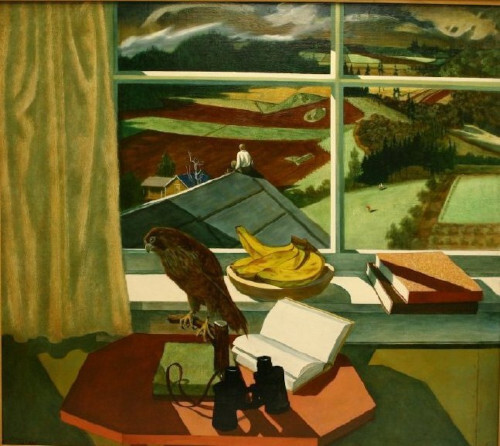Domain
Made in 1948-1949, Domain is a fairly unique work in Hall’s oeuvre as it is not entirely a landscape, isn’t a genre scene (a scene of everyday life), and isn’t a still life. The painting’s perspective is a view from indoors looking through a window to the outdoors. In the foreground is a red table with an unidentified bird sitting on a peg (Carl Hall was a lover of birds), upside-down binoculars, and an open book resting on a table with blank pages. On the windowsill is a bowl of slightly brown bananas and two books sitting on the windowsill but halfway off of it. The yellow-green curtains of the window are pulled back to the viewer’s left, revealing four panes of glass that overlook the Willamette Valley. In this landscape, we see the roof of a house with a man sitting on the edge (perhaps Carl Hall) as he looks at the richly irrigated land, the people walking on it, such as the small figures on the right bottom right, and perhaps watching the sunset/sunrise develop yellow and blue in the sky.
The palette is quintessentially Carl Hall, with earth tones of green and brown and some white thrown into a landscape that continues farther than the eye can see. As is typical for Carl Hall, his draughtsmanship is precise, with a clear and shiny patina (the surface texture of the paint) and little to no visible brushstrokes. The lighting in the interior part of the painting is exquisite, with every object casting shadow- even the window panes -perhaps a product of a setting sun.
In Eden Again, Domain is described as a scene of domesticity, a life Carl Hall was unsure would be available to him while he was at war. There's a house, a bird, provisions, a blank book with pages not written in just as Hall’s life in Oregon was not yet figured out, and a view of his favorite place- the Willamette Valley. However, there is more to the painting than meets the eye. In still-life paintings, the objects depicted symbolize something else; thus, the interior of this painting, which resembles a still life, is potentially symbolic in the same way. The windowsill, for instance, has browning bananas, not ripe but not dying- they’re aging slowly- and holds books hanging off precariously, suggesting that they are safe for now but in danger. Alongside these objects by the window are the blank open book, the bird, and the binoculars turned down- not looking for the bird in front of it. Perhaps these show the way life is constantly changes, sometimes in an unknown way (the blank book), or perhaps they are simply markers of Hall’s life.
The painting is also interesting in terms of how it is obscured from us. The window panes block our view, and the curtains are pulled back for us to allow us to see- like Hall controlling our viewing experience and alerting us to that fact. Perhaps the curtains shield us from the entire view of the landscape to show the unknowability of such a universal force like the land.
It is possible Hall screened off viewers because he was replicating old masters like The Visitation by Rembrandt, seen through a doorway. But curtains and obstructions of view were common in art history, such as the famous Sistine Madonna by Raphael (1483-1520) from 1512 or various Johannes Vermeer (1632-1675) paintings such as the 1657-1659 painting Girl Reading by an Open Window. They impart a certain theatricality and sense of temporality to a work as it is implied someone opened the curtain. In Domain, it is possible the viewers have opened the curtain, or perhaps the artist did, and we are at the mercy of whatever he deems fit to show us.

